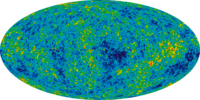
Photo from wikipedia
The bright polarized synchrotron emission, away from the Galactic plane, originates mostly from filamentary structures. We implement a filament finder algorithm which allows the detection of bright elongated structures in… Click to show full abstract
The bright polarized synchrotron emission, away from the Galactic plane, originates mostly from filamentary structures. We implement a filament finder algorithm which allows the detection of bright elongated structures in polarized intensity maps. We analyse the sky at 23 and 30 GHz as observed respectively by WMAP and Planck. We identify 19 filaments, 13 of which have been previously observed. For each filament, we study the polarization fraction, finding values typically larger than for the areas outside the filaments, excluding the Galactic plane, and a fraction of about 30% is reached in two filaments. We study the polarization spectral indices of the filaments, and find a spectral index consistent with the values found in previous analysis (about -3.1) for more diffuse regions. Decomposing the polarization signals into the E and B families, we find that most of the filaments are detected in PE , but not in PB . We then focus on understanding the statistical properties of the diffuse regions of the synchrotron emission at 23 GHz. Using Minkowski functionals and tensors, we analyse the non-Gaussianity and statistical isotropy of the polarized intensity maps. For a sky coverage corresponding to 80% of the fainter emission, and on scales smaller than 6 degrees (ℓ > 30), the deviations from Gaussianity and isotropy are significantly higher than 3σ. The level of deviation decreases for smaller scales, however, it remains significantly high for the lowest analised scale (∼ 1.5°). When 60% sky coverage is analysed, we find that the deviations never exceed 3σ. Finally, we present a simple data-driven model to generate non-Gaussian and anisotropic simulations of the synchrotron polarized emission. The simulations are fitted in order to match the spectral and statistical properties of the faintest 80% sky coverage of the data maps.
Journal Title: Journal of Cosmology and Astroparticle Physics
Year Published: 2023
Link to full text (if available)
Share on Social Media: Sign Up to like & get
recommendations!